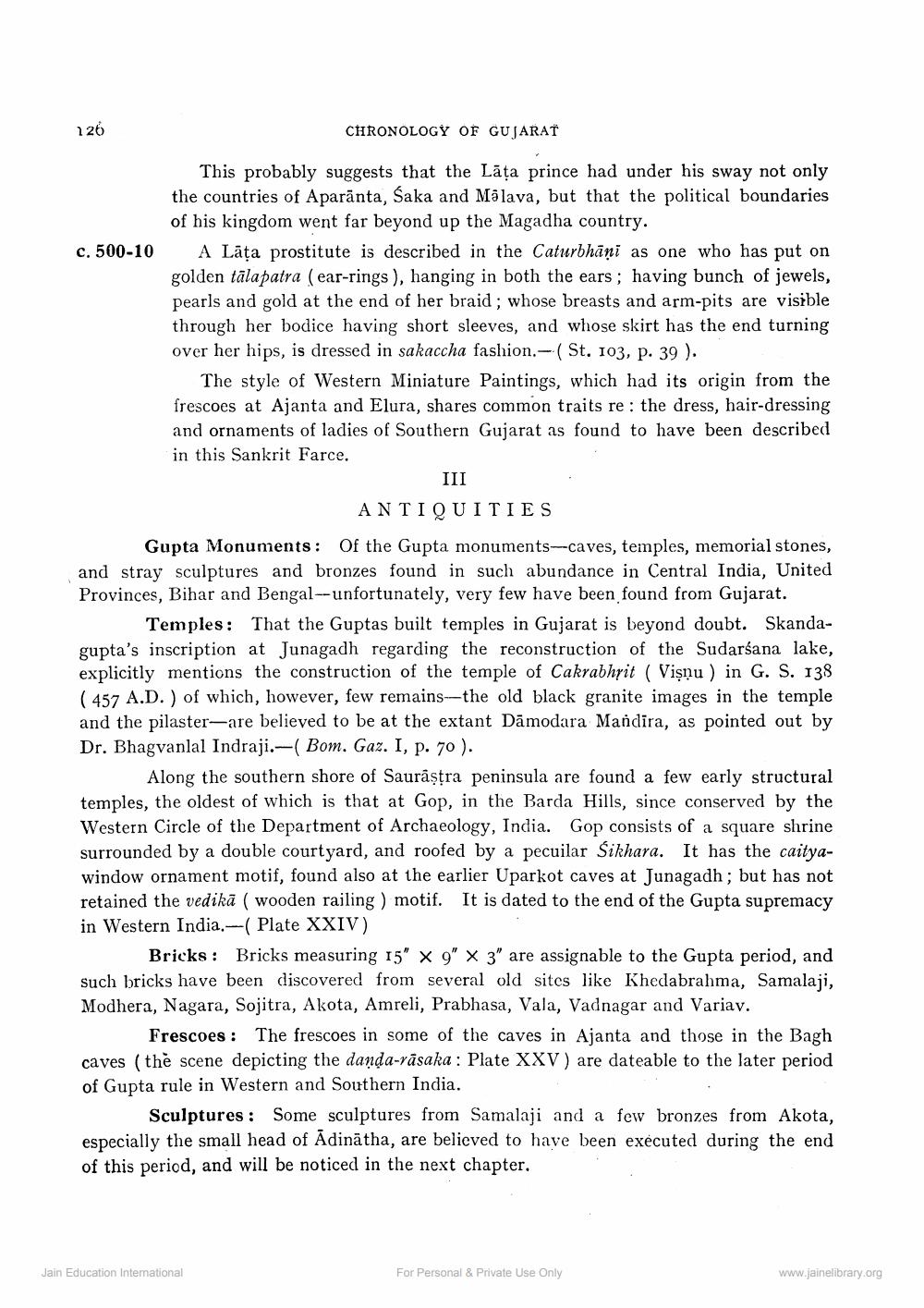________________
126
CHRONOLOGY OF GUJARAT
This probably suggests that the Lăța prince had under his sway not only the countries of Aparānta, Saka and Mālava, but that the political boundaries
of his kingdom went far beyond up the Magadha country. c. 500-10 A Lāța prostitute is described in the Caturbhāni as one who has put on
golden tālapatra (ear-rings ), hanging in both the ears; having bunch of jewels, pearls and gold at the end of her braid ; whose breasts and arm-pits are visible through her bodice having short sleeves, and whose skirt has the end turning over her hips, is dressed in sakaccha fashion.- ( St. 103, p. 39 ).
The style of Western Miniature Paintings, which had its origin from the frescoes at Ajanta and Elura, shares common traits re: the dress, hair-dressing and ornaments of ladies of Southern Gujarat as found to have been described in this Sankrit Farce.
III
ANTIQUITIES Gupta Monuments: Of the Gupta monuments---caves, temples, memorial stones, and stray sculptures and bronzes found in such abundance in Central India, United Provinces, Bihar and Bengal--unfortunately, very few have been found from Gujarat.
Temples: That the Guptas built temples in Gujarat is beyond doubt. Skandagupta's inscription at Junagadh regarding the reconstruction of the Sudarsana lake, explicitly mentions the construction of the temple of Cakrabhrit (Vişnu) in G. S. 138 ( 457 A.D.) of which, however, few remains-the old black granite images in the temple and the pilaster-are believed to be at the extant Dāmodara Mandira, as pointed out by Dr. Bhagvanlal Indraji.-(Bom. Gaz. I, p. 70 ).
Along the southern shore of Saurāṣtra peninsula are found a few early structural temples, the oldest of which is that at Gop, in the Barda Hills, since conserved by the Western Circle of the Department of Archaeology, India. Gop consists of a square shrine surrounded by a double courtyard, and roofed by a pecuilar Sikhara. It has the caityawindow ornament motif, found also at the earlier Uparkot caves at Junagadh; but has not retained the vedikā ( wooden railing ) motif. It is dated to the end of the Gupta supremacy in Western India.--( Plate XXIV)
Bricks: Bricks measuring 15" x 9" x 3" are assignable to the Gupta period, and such bricks have been discovered from several old sites like Khedabrahma, Samalaji, Modhera, Nagara, Sojitra, Akota, Amreli, Prabhasa, Vala, Vadnagar and Variav.
Frescoes: The frescoes in some of the caves in Ajanta and those in the Bagh caves (the scene depicting the danda-rāsaka : Plate XXV) are dateable to the later period of Gupta rule in Western and Southern India.
Sculptures : Some sculptures from Samalaji and a few bronzes from Akota, especially the small head of Adinatha, are believed to have been exécuted during the end of this period, and will be noticed in the next chapter,
Jain Education Intemational
For Personal & Private Use Only
www.jainelibrary.org




